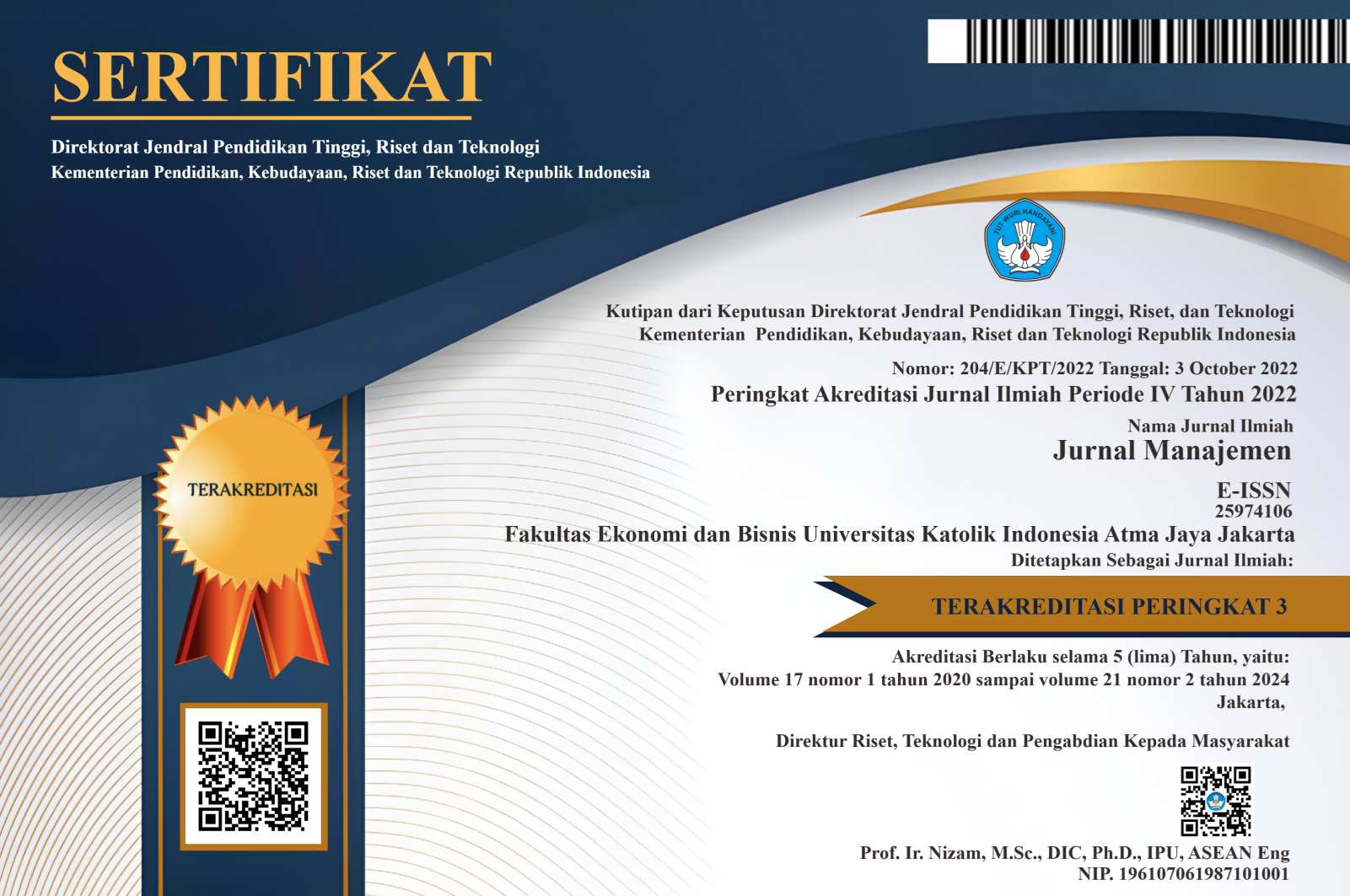THE IMPACT OF E-SERVICE QUALITY ON USER SATISFACTION OF ONLINE HEALTH SERVICE WITH TRUST AS A MEDIATOR
DOI:
https://doi.org/10.25170/jm.v22i1.5162Keywords:
E-Service Quality, Trust, Satisfaction, User Interface, Customer ServiceAbstract
The research focuses on the impact of e-service quality on customer satisfaction of Halodoc with the mediation of trust. There are 6 variables – namely, user interface, responsiveness, need fulfillment, security, and customer service – which will be examined whether they have a direct effect on satisfaction and trust as mediation on customer satisfaction. This research involved respondents aged 17-50 years in Jakarta, Bogor, Depok, Tangerang, Bekasi. Data was collected online using Google Forms. The data were processed using SMART PLS to solve the 11 hypotheses of this study. The results of this study indicate that trust, user interface, and responsiveness do not have a direct effect on satisfaction. Meanwhile, need fulfillment and customer service have a direct influence on satisfaction. Trust as a mediator influences the effect of security on satisfaction, and customer service on satisfaction. Meanwhile, the user interface variables, responsiveness, and need fulfillment through trust mediation do not affect satisfaction.
References
Akhondi, A. and Kafashpor, A. (2016). Investigating influence of trust on repurchasing by mediating role of customer satisfaction in online stores. Modern Applied Science, 10(6), 126. https://doi.org/10.5539/mas.v10n6p126
Anderson, E. W., Fornell, C., & Lehmann, D. R. (1994). Customer Satisfaction, Market Share, and Profitability: Findings from Sweden. Journal of Marketing, 58(3), 53-66. https://doi.org/10.1177/002224299405800304
Apidana, Y. (2023). The influence of e-trust and e-servqual on e-repurchase intention with e-satisfaction as an intervening variable. Jurnal Ilmiah Manajemen Kesatuan, 11(3), 1075-1086. https://doi.org/10.37641/jimkes.v11i3.2241
Ashiq, R., & Hussain, A. (2024). Exploring the effects of e-service quality and e-trust on consumers' e-satisfaction and e-loyalty: Insights from online shoppers in pakistan. Journal of Electronic Business & Digital Economics, 3(2), 117-141. https://doi.org/10.1108/JEBDE-09-2023-0019
Bahrun, S., Alifah, S., & Mulyono, S. (2017). Rancang Bangun Sistem Informasi Survey Pemasaran dan Penjualan Berbasis Web. In Jurnal Transistor Elektro dan Informatika TRANSISTOR EI 2(2), 81-88.
Blut, M. (2016). E-Service Quality: Development of a Hierarchical Model. Journal of Retailing, 92(4), 500-517. https://doi.org/10.1016/j.jretai.2016.09.002
Blut, M., Chowdhry, N., Mittal, V., & Brock, C. (2015). E-Service Quality: A Meta-Analytic Review. In Journal of Retailing, 91(4), 679-700. https://doi.org/10.1016/j.jretai.2015.05.004
Bohórquez, M. R., Lara-Bocanegra, A., Teva, R., García-Fernández, J., Grimaldi-Puyana, M., & Gálvez-Ruiz, P. (2024). From e-service quality to behavioral intention to use e-fitness services post COVID-19 lockdown: When a crisis changes the social mindset. Heliyon, 10(9), 1-11
Cardinali, R. (1994). Productivity improvements through the use of graphic user interfaces. Industrial Management & Data Systems, 94(4), 3-7.
Databoks. (2020). Indonesia Peringkat ke-3 Global Memanfaatkan Aplikasi Kesehatan | Databoks. https://databoks.katadata.co.id/datapublish/2020/10/13/indonesia-peringkat-ke-3-global-memanfaatkan-aplikasi-kesehatan
Davis, M. M., & Heineke, J. (1998). How disconfirmation, perception and actual waiting times impact customer satisfaction. International Journal of Service industry Management, 9(1), 64-73.
Deyalage, P. and Kulathunga, D. (2019). Factors affecting online customer satisfaction: the sri lankan perspective. International Journal of Business and Management, 14(2), 99. https://doi.org/10.5539/ijbm.v14n2p99
Gambetta, D. (2000). Can we trust trust. Trust: Making and breaking cooperative relations, 13, 213-237.
Gounaris, S., Dimitriadis, S., & Stathakopoulos, V. (2010). An examination of the effects of service quality and satisfaction on customers’ behavioral intentions in e-shopping. Journal of Services Marketing, 24(2), 142-156. https://doi.org/10.1108/08876041011031118
Gummerus, J., Liljander, V., Pura, M., & Van Riel, A. (2004). Customer loyalty to content-based Web sites: The case of an online health-care service. Journal of Services Marketing, 18(3), 175–186. https://doi.org/10.1108/08876040410536486
Hair, J., Black, W., Babin, B., & Anderson, R. (2010). Multivariate Data Analysis: A Global Perspective. In Multivariate Data Analysis: A Global Perspective.
Hair, J. F., Risher, J. J., Sarstedt, M., & Ringle, C. M. (2019). When to use and how to report the results of PLS-SEM. European Business Review, 31(1), 2–24. https://doi.org/10.1108/EBR-11-2018-0203
Iglesias, M. P., & Guillén, M. J. Y. (2004). Perceived quality and price: their impact on the satisfaction of restaurant customers. International Journal of Contemporary hospitality management, 16(6), 373-379.
Jayachandran, S., & Varadarajan, R. (2006). Does success diminish competitive responsiveness? Reconciling conflicting perspectives. Journal of the Academy of Marketing Science, 34(3), 284-294. https://doi.org/10.1177/0092070304272406
Jiao, L., Bai, J., Zhao, H., & Zhang, X. (2023). The effect of “Offline-to-online” trust transfer on the utilization of online medical consultation among chinese rural residents: Experimental study. Journal of Medical Internet Research, 25(1), 1-19. https://doi.org/10.2196/43430
Junaedi, Maranto, A. R. K., Putri, M. P., & Suwitno (2023). User interface experience analysis of pmb online buddhi dharma using system usability scale. Bit-Tech, 6(2), 2016-222. https://doi.org/10.32877/bt.v6i2.1051
Kemkes. (2023). SIKLUS HIDUP. https://ayosehat.kemkes.go.id/kategori-usia/usia-produktif
Kemp, S. (2022). digital 2022: Indonesia — DataReportal – Global digital Insights. DataReportal. from https://datareportal.com/reports/digital-2022-indonesia
Khan, F. N., Arshad, M. U., & Munir, M. (2023). Impact of e-service quality on e-loyalty of online banking customers in pakistan during the covid-19 pandemic: Mediating role of e-satisfaction. Future Business Journal, 9 (1), 1-12. doi:https://doi.org/10.1186/s43093-023-00201-8
Kim, J., & Lennon, S. J. (2013). Effects of reputation and website quality on online consumers’ emotion, perceived risk and purchase intention: Based on the stimulus-organism-response model. Journal of Research in Interactive Marketing, 7(1), 33–56. https://doi.org/10.1108/17505931311316734
Krush, M. T., Sohi, R. S., & Saini, A. (2015). Dispersion of marketing capabilities: impact on marketing’s influence and business unit outcomes. Journal of the Academy of Marketing Science, 43 (1), 32-51 https://doi.org/10.1007/s11747-014-0420-7
Lee, G. G., & Lin, H. F. (2005). Customer perceptions of e-service quality in online shopping. International Journal of Retail and Distribution Management 33(2), 161–176. https://doi.org/10.1108/09590550510581485
Lengkong, A. (2023). The influence of service quality and consumer trust towards customer satisfaction on shopee in manado. Jurnal Emba Jurnal Riset Ekonomi Manajemen Bisnis Dan Akuntansi, 11(02), 1-10. https://doi.org/10.35794/emba.v11i02.47537
Mayer, R. C., Davis, J. H., & Schoorman, F. D. (1995). An Integrative Model Of Organizational Trust. Academy of Management Review, 20(3), 709-734. https://doi.org/10.5465/amr.1995.9508080335
Mamakou, X. J., Zaharias, P., & Milesi, M. (2024). Measuring customer satisfaction in electronic commerce: The impact of e-service quality and user experience. International Journal of Quality & Reliability Management, 41(3), 915-943.
Parasuraman, A., Zeithaml, V. A., & Malhotra, A. (2005). E-S-QUAL a multiple-item scale for assessing electronic service quality. Journal of Service Research, 7(3), 213-233. https://doi.org/10.1177/1094670504271156
Perera, G. and Sachitra, K. (2019). Customer satisfaction towards online shopping in sri lanka: moderating effect of income level. Asian Journal of Advanced Research and Reports, 6(2), 1-10. https://doi.org/10.9734/ajarr/2019/v6i230149
Phiri, M. A., & Mcwabe, T. (2013). Customers’ Expectations and Perceptions of Service Quality: The Case of Pick N Pay Supermarket Stores in Pietermaritzburg Area, South Africa. International Journal of Research in Social Sciences, 3(1), 96-104.
Qin, H., & Prybutok, V. R. (2009). Service quality, customer satisfaction, and behavioral intentions in fast-food restaurants. International Journal of Quality and Service Sciences, 1(1), 78-95. https://doi.org/10.1108/17566690910945886
Ramadania, R. (2021). E-s-qual and e-recs-qual toward customer satisfaction, trust and loyalty in electronic banking services during the covid-19 pandemic. Matrik Jurnal Manajemen Strategi Bisnis Dan Kewirausahaan, 15(1), 100-108 https://doi.org/10.24843/matrik:jmbk.2021.v15.i01.p09
Rita, P., Oliveira, T., & Farisa, A. (2019). The impact of e-service quality and customer satisfaction on customer behavior in online shopping. Heliyon, 5(10), 1-14. https://doi.org/10.1016/j.heliyon.2019.e02690
Salvador, F., Chandrasekaran, A., & Sohail, T. (2014). Product configuration, ambidexterity and firm performance in the context of industrial equipment manufacturing. Journal of Operations Management,32(4), 138-153. https://doi.org/10.1016/j.jom.2014.02.001
Theoharakis, V., Sajtos, L., & Hooley, G. (2009). The strategic role of relational capabilities in the business-to-business service profit chain. Industrial Marketing Management, 38(8), 914-924. https://doi.org/10.1016/j.indmarman.2009.04.006
Top Brand Index Beserta Kategori Lengkap. (n.d.). (2022). Top Brand Index. https://www.topbrand-award.com/top-brand-index/
Wolfinbarger, M., & Gilly, M. C. (2003). eTailQ: Dimensionalizing, measuring and predicting retail quality. Journal of Retailing, 79(3), 183-198. https://doi.org/10.1016/S0022-4359(03)00034-
Yang, Z., Jun, M., & Peterson, R. T. (2004). Measuring customer perceived online service quality: Scale development and managerial implications. In International Journal of Operations and Production Management, 24(11), 1149–1174 https://doi.org/10.1108/01443570410563278
Zeithaml, V. A., Parasuraman, A., & Malhotra, A. (2000). A Conceptual Framework for Understanding e-Service Quality: Implications for Future Research and Managerial Practice. Marketing Science Institute, 1-50.
Downloads
Published
Issue
Section
License
Copyright (c) 2025 Febby Angelina Yenchristie, Efendi

This work is licensed under a Creative Commons Attribution-NonCommercial-ShareAlike 4.0 International License.
Authors who publish with this journal agree to the following terms:
Authors retain copyright and grant the journal right of first publication with the work simultaneously licensed under a Creative Commons Attribution-NonCommercial-ShareAlike License that allows others to share the work with an acknowledgement of the work's authorship and initial publication in this journal.
Authors are able to enter into separate, additional contractual arrangements for the non-exclusive distribution of the journal's published version of the work (e.g., post it to an institutional repository or publish it in a book), with an acknowledgement of its initial publication in this journal.
Authors are permitted and encouraged to post their work online (e.g., in institutional repositories or on their website) prior to and during the submission process, as it can lead to productive exchanges, as well as earlier and greater citation of published work (See the Effect of Open Access).












